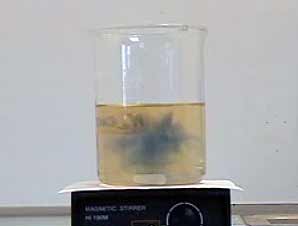Briggs–Rauscher reaction
The Briggs - Rauscher reaction (also oscillating iodine clock ) belongs to the small number of known oscillating reactions in homogeneous solution. The reaction is particularly suitable for the color changes, the present mechanism oscillating responses. The color changes from colorless to deep blue run yellowish over which returns to the colorless initial state to go through the cycle several times.
History
The first homogeneous oscillating chemical reaction was found by WC Bray in 1921. It is a reaction of hydrogen peroxide ( H2O2) and iodate ( IO3 - ) in acidic solution. Because of the experimental difficulties, the reaction got little attention and was not suitable for the demonstration of the effect. BP Belousov discovered in 1958 in the Soviet Union, the Belousov -Zhabotinsky reaction, which was also met with skepticism, since up to this point oscillating reactions were unknown. AM Zhabotinsky published his research results on this reaction in 1964., And in May 1972 in the Journal of Chemical Education Through these publications, two scientific staff of the Galileo High School were aware of the reaction in San Francisco. They then developed the oscillating Briggs - Rauscher reaction by replacing bromate the Belousov -Zhabotinsky reaction by iodate and starch as indicator. The so-called oscillating iodine clock showed the reactions proceeding.
Mechanism
The detailed reaction mechanism is complex. As important steps two key processes can be described:
- A non- free-radical process A: the slow response of free iodine and malonic acid in the presence of iodate under production of an intermediate iodide ion.
- A radical process B: a fast autocatalytic process of manganate and free radicals, which cause the water and the iodate to free iodine and oxygen. This process consumes iodine to the rate-determining step. Process B can occur only at low concentrations of iodide, which otherwise triggers a feedback process.
Initially, the iodide concentration is low and the process B generates free iodine, which accumulates slowly. Meanwhile, the process A slowly generates the intermediate iodide ion with increasing rate from the free iodine. At a certain point, the reaction is suppressed, thus stopping the process B, the production of free iodine (and iodide), until the concentration has decreased so far that process B expires again. The process proceeds until all of the reactants are consumed.
The reaction can be described approximately by the following equation:
The color change of the process corresponding to the kinetics of the two processes. The slowly rising yellowish color is due to the production of free iodine by process B. If the process B stops, the increasing concentration of iodide ions leads to color changes to blue by the strength complex. Because is still ongoing process A, the color change goes back to the colorless solution. The eventual resumption of the process B is not visible, but can be detected electrochemically.
A negative feedback, with a delay, which is mediated by Process A, is the general mechanism to generate oscillating reactions in physical systems, but is rarely seen in non- homogenous biological chemical reactions.









